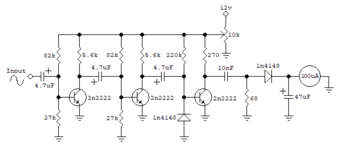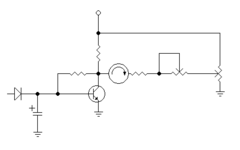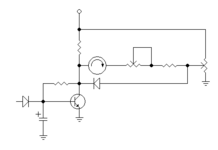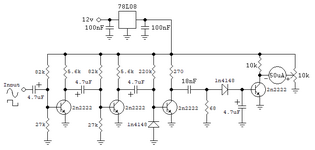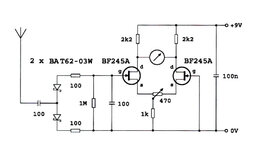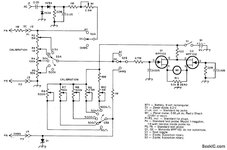neazoi
Advanced Member level 6
Hi this is a simple audio frequency to voltage converter I have designed with the help of a few members here.
I use it to measure 480Hz-2700Hz tones. 480Hz is the minimum frequency required, below that I do not care.
Now what I need, is to narrow it's bandwidth (i.e. achieve full meter scale by lower maximum frequencies audio tones). One way, is to use a 50uA meter instead of 100uA. This will allow a meter peaking at a lower frequency (around half).
But instead of doing so, I was thinking that I could use an amplifier just before the meter.
The amplifier should detect the different voltage levels on the electrolytic near the meter and drive the meter. This way I could use a higher current meter. Obviously the amplifier should not load the input capacitor too much, so as not to produce erroneous readings.
What do you suggest me to do?
A simple 2n7000 could do the job? or maybe a bjt like 2n2222?
Please suggest me a simple circuit to achieve what I need.
The narrower the bandwidth I can achieve, the better for me. That is full deflection of the meter for only 100Hz or even less.
I use it to measure 480Hz-2700Hz tones. 480Hz is the minimum frequency required, below that I do not care.
Now what I need, is to narrow it's bandwidth (i.e. achieve full meter scale by lower maximum frequencies audio tones). One way, is to use a 50uA meter instead of 100uA. This will allow a meter peaking at a lower frequency (around half).
But instead of doing so, I was thinking that I could use an amplifier just before the meter.
The amplifier should detect the different voltage levels on the electrolytic near the meter and drive the meter. This way I could use a higher current meter. Obviously the amplifier should not load the input capacitor too much, so as not to produce erroneous readings.
What do you suggest me to do?
A simple 2n7000 could do the job? or maybe a bjt like 2n2222?
Please suggest me a simple circuit to achieve what I need.
The narrower the bandwidth I can achieve, the better for me. That is full deflection of the meter for only 100Hz or even less.
